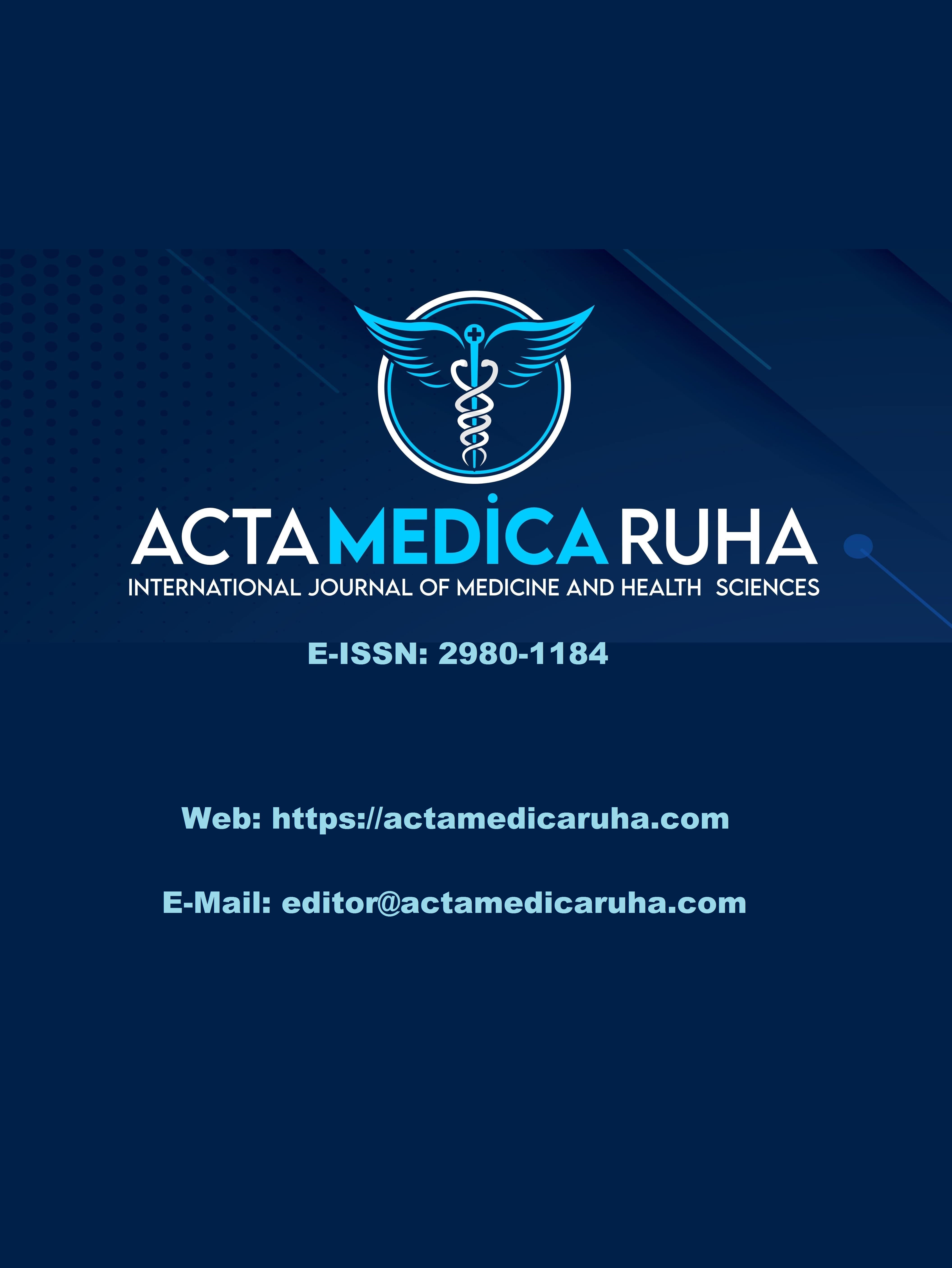Gebelikte Serbest ß-hCG, PAPP-A, AFP, ß-hCG, UE3’in AKŞ, 50 Gram Glukoz Tarama Testi Ve Bebek Doğum Ağırlığı İle İlişkisi
DÜZELTME: Araştırma Makalesi
DOI:
https://doi.org/10.5281/zenodo.8262574Anahtar Kelimeler:
gestasyonel diabetes mellitus, anormal doğum ağırlığı, trimestır, gebelikle ilişkili plazma protein-A (PAPP-A), gebe konjuge olmayan estriol (uE3)Özet
Amaç: Anormal fetal doğum ağırlığı ile doğan bebeklerde komplikasyonların yakından izlenmesi ile sağlık ve bakım kalitesinin artırılması ve yüksek maliyetli tıbbi harcamaların en aza indirilmesi mümkündür. Bu araştırma kapsamında, gestasyonel diyabet taramasında kullanılan 50 g glukoz tolerans testi değerleri ile tahmini doğum ağırlığı ile birinci ve ikinci trimester tarama testleri plazma proteinleri arasındaki ilişkiyi ortaya koymayı amaçladık.
Yöntem: Ankara Atatürk Eğitim ve Araştırma Hastanesi, Kadın Hastalıkları ve Doğum Kliniği'nde düzenli antenatal takipleri olan toplam 831 olgu çalışmaya alındı. Birinci trimester fetal anöploidi taraması PAPP-A ve serbest-β-hCG değerlerini belirledi. İkinci trimester üçlü testi, Alfa-feto protein, hCG ve konjuge olmayan estriol değerlerini belirledi. İlk vizitte açlık kan şekeri ölçüldü ve 24-28. gebelik haftaları arasında 50 gr oral glukoz tolerans testi (OGTT) yapıldı.Gebelikleri komplikasyonsuz devam eden ve miadında (gebelik yaşı 37+0 hafta) doğum yapanlar çalışmaya dahil edildi.
Bulgular: Birinci ve ikinci trimester anöploidi taramasında kullanılan hormon değerleri ile 50 gr OGTT (mg/dl) değerleri arasındaki ilişki incelendiğinde, serbest-beta-hCG ile 50 gr OGTT (mg/dl) arasında korelasyon saptanmadı (r= -0.055, p= 0.128). Maternal açlık kan şekeri düzeyleri (r= -0.055, p= 0.131) birinci ve ikinci trimester anöploidi taraması ile herhangi bir ilişki göstermedi. PAPP-A (r= - 0.011, p= 0.765), AFP (r= -0.033, p= 0.369), uE3 (r= 0.035, p= 0.340) ve hCG değerleri (r= -0.051, p= 0.164) de anne açlık kan şekeri seviyeleri ile korelasyon göstermedi.
Sonuç: Çalışmamızın sonuçlarına göre birinci trimesterde kullanılan hormonlar (PAPP-A ve serbest-beta-hCG) ve ikinci trimesterde (AFP, hCG ve uE3)anöploidi taraması ile 50 g OGTT, maternal plazma kan şekeri düzeyi ve doğum ağırlığı arasında ilişki bulunmadı.
Referanslar
Sweeting A, Wong J, Murphy HR, Ross GP. A Clinical Update on Gestational Diabetes Mellitus. Endocr Rev. 2022;43(5):763-793. doi:10.1210/endrev/bnac003
Karavasileiadou S, Almegwely W, Alanazi A, Alyami H, Chatzimichailidou S. Self-management and self-efficacy of women with gestational diabetes mellitus: a systematic review. Glob Health Action. 2022;15(1):2087298. doi:10.1080/16549716.2022.2087298
Sharma AK, Singh S, Singh H, et al. Deep Insight of the Pathophysiology of Gestational Diabetes Mellitus. Cells. 2022;11(17):2672. doi:10.3390/cells11172672
Huang T, Bellai-Dussault K, Meng L, et al. First and second trimester maternal serum markers for prenatal aneuploidy screening: An update on the adjustment factors for race, smoking, and insulin dependent diabetes mellitus. Clin Biochem. 2023;118:110596. doi:10.1016/j.clinbiochem.2023
Yildiz A, Yozgat ST, Cokmez H, Yildiz FŞ. The predictive value of the first trimester combined test for gestational diabetes mellitus. Ginekol Pol. 2023;94(5):395-399. doi:10.5603/GP.a2022.0036
Giorgione V, Quintero Mendez O, Pinas A, Ansley W, Thilaganathan B. Routine first-trimester pre- eclampsia screening and risk of preterm birth. Ultrasound Obstet Gynecol. 2022;60(2):185-191. doi:10.1002/uog.24915
Yang Z, Wang S, Zheng R, et al. Value of PAPP-A combined with BMI in predicting the prognosis of gestational diabetes mellitus: an observational study. J Obstet Gynaecol. 2022;42(7):2833-2839. doi:10.1080/01443615.2022.2109951
Cui J, Li P, Chen X, et al. Study on the Relationship and Predictive Value of First-Trimester Pregnancy-Associated Plasma Protein-A, Maternal Factors, and Biochemical Parameters in Gestational Diabetes Mellitus: A Large Case-Control Study in Southern China Mothers. Diabetes Metab Syndr Obes. 2023;16:947-957. doi:10.2147/DMSO.S398530
Yanachkova V, Staynova R, Stankova T, Kamenov Z. Placental Growth Factor and Pregnancy- Associated Plasma Protein-A as Potential Early Predictors of Gestational Diabetes Mellitus. Medicina (Kaunas). 2023;59(2):398. doi: 10.3390/medicina59020398
Wicklow B, Retnakaran R. Gestational Diabetes Mellitus and Its Implications across the Life Span. Diabetes Metab J. 2023;47(3):333-344. doi:10.4093/dmj.2022.0348
Bukhari I, Iqbal F, Thorne RF. Editorial: Relationship between gestational and neonatal diabetes mellitus. Front Endocrinol (Lausanne). 2022;13:1060147. doi:10.3389/fendo.2022.1060147
Malaza N, Masete M, Adam S, Dias S, Nyawo T, Pheiffer C. A Systematic Review to Compare Adverse Pregnancy Outcomes in Women with Pregestational Diabetes and Gestational Diabetes. Int J Environ Res Public Health. 2022;19(17):10846. doi:10.3390/ijerph191710846
Nolan CJ. Gestational Diabetes Mellitus and the Maternal Heart. Diabetes Care. 2022;45(12):2820-2822. doi:10.2337/dci22-0036
Shen Y, Zheng Y, Su Y, et al. Insulin sensitivity, β cell function, and adverse pregnancy outcomes in women with gestational diabetes. Chin Med J (Engl). 2022;135(21):2541-2546. doi:10.1097/CM9.0000000000002337
Blasetti A, Quarta A, Guarino M, et al. Role of Prenatal Nutrition in the Development of Insulin Resistance in Children. Nutrients. 2022;15(1):87. doi: 10.3390/nu15010087
Thaweethai T, Soetan Z, James K, Florez JC, Powe CE. Distinct Insulin Physiology Trajectories in Euglycemic Pregnancy and Gestational Diabetes Mellitus. Diabetes Care. 2023;1:dc222226. doi:10.2337/dc22-2226
Kabbani N, Blüher M, Stepan H, et al. Adipokines in Pregnancy: A Systematic Review of Clinical Data. Biomedicines. 2023;11(5):1419. doi:10.3390/biomedicines11051419
Gibson C, de Ruijter-Villani M, Stout TAE. Insulin-like growth factor system components expressed at the conceptus-maternal interface during the establishment of equine pregnancy. Front Vet Sci. 2022;9:912721. doi:10.3389/fvets.2022.912721
Conover CA, Oxvig C. The Pregnancy-Associated Plasma Protein-A (PAPP-A) Story. Endocr Rev. 2023;2:bnad017. doi:10.1210/endrev/bnad017
Savvidou MD, Syngelaki A, Muhaisen M, Emelyanenko E, Nicolaides KH. First trimester maternal serum free β-human chorionic gonadotropin and pregnancy-associated plasma protein A in pregnancies complicated by diabetes mellitus. BJOG. 2012;119(4):410-6. doi:10.1111/j.1471-0528.2011.03253.x
Papamichail M, Fasoulakis Z, Daskalakis G, Theodora M, Rodolakis A, Antsaklis P. Importance of Low Pregnancy Associated Plasma Protein-A (PAPP-A) Levels During the First Trimester as a Predicting Factor for Adverse Pregnancy Outcomes: A Prospective Cohort Study of 2636 Pregnant Women. Cureus. 2022;14(11):e31256. doi:10.7759/cureus.31256
Movahedi M, Khanjani S, Shahshahan Z, Hajihashemi M, Farahbod F, Shahsavandi E. Evaluation of the Relationship between Pregnancy-Associated Plasma Protein A (PAPP-A) and Pregnancy Outcomes. Adv Biomed Res. 2023;12:91. doi:10.4103/abr.abr_344_21
Caron L, Ghesquiere L, Bujold E. Pregnancy associated plasma protein-A for the prediction of small for gestational age. J Perinat Med. 2023;51(5):718-719. doi:10.1515/jpm-2022-0545
Villar J, Ochieng R, Gunier RB, et al. Association between fetal abdominal growth trajectories, maternal metabolite signatures early in pregnancy, and childhood growth and adiposity: prospective observational multinational INTERBIO-21st fetal study. Lancet Diabetes Endocrinol. 2022;10(10):710-719. doi:10.1016/S2213-8587(22)00215-7
Habayeb O, Daemen A, Timmerman D, et al. The relationship between first trimester fetal growth, pregnancy-associated plasma protein A levels and birthweight. Prenat Diagn. 2010;30(9):873-8. doi:10.1002/pd.2578
Pedersen JF, Sørensen S, Mølsted-Pedersen L. Serum levels of human placental lactogen, pregnancy-associated plasma protein A and endometrial secretory protein PP14 in first trimester of diabetic pregnancy. Acta Obstet Gynecol Scand. 1998;77(2):155-8.
Bader D, Riskin A, Vafsi O, et al. Alpha-fetoprotein in the early neonatal period--a large study and review of the literature. Clin Chim Acta. 2004;349(1-2):15-23. doi:10.1016/j.cccn.2004.06.020
Roig MD, Sabrià J, Valls C, et al. The use of biochemical markers in prenatal diagnosis of intrauterine growth retardation: insulin-like growth factor I, Leptin, and alpha-fetoprotein. Eur J Obstet Gynecol Reprod Biol. 2005;120(1):27-32. doi:10.1016/j.ejogrb.2004.07.028
Morris RK, Cnossen JS, Langejans M, et al. Serum screening with Down's syndrome markers to predict pre-eclampsia and small for gestational age: systematic review and meta-analysis. BMC Pregnancy Childbirth. 2008;8:33. doi:10.1186/1471-2393-8-33
Nagata C, Iwasa S, Shiraki M, Shimizu H. Estrogen and alpha-fetoprotein levels in maternal and umbilical cord blood samples in relation to birth weight. Cancer Epidemiol Biomarkers Prev. 2006;15(8):1469-72. doi:10.1158/1055-9965.EPI-06-0158
İndir
Yayınlanmış
Nasıl Atıf Yapılır
Sayı
Bölüm
Lisans
Telif Hakkı (c) 2023 Acta Medica Ruha

Bu çalışma Creative Commons Attribution 4.0 International License ile lisanslanmıştır.











